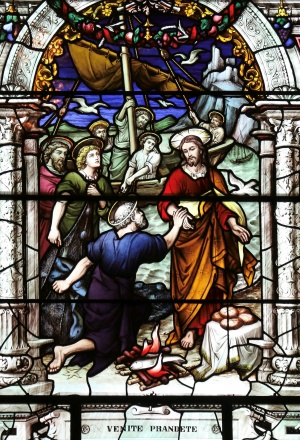Youth & Young Adult Ministry: Spiritual Multiplication: What Exactly Are We Talking About?
 How do you bring someone to faith in Jesus Christ? As Christians, this is a question we should have a ready-made answer for.
How do you bring someone to faith in Jesus Christ? As Christians, this is a question we should have a ready-made answer for.
Practicing Organic Reading with the Catechism
In its “practical directions” for reading the Catechism the authors have placed a brief instruction:
This catechism is conceived as an organic presentation of the Catholic faith in its entirety. It should be seen therefore as a unified whole. Numerous cross-references in the margin of the text (numbers found at the end of a sentence referring to other paragraphs that deal with the same theme), as well as the analytical index at the end of the volume, allow the reader to view each theme in its relationship with the entirety of the faith.[1]
What is the meaning of such a direction? What would such a practice look like? How should it be undertaken and what is its value?
Reclaiming Old Catechisms for the New Evangelization
Even in these days of unprecedented access to information, some are surprised to find that there are more than a few catechisms in Church history. In fact, Catholics are heirs to such a wealth of these texts that they defy precise enumeration, having been penned and promulgated throughout the last millennium by bishops and councils all around the world. Amid the renewal of catechetical methods called for in the 2020 Directory for Catechesis, scores of these priceless guidebooks of faith from the past are being remastered and republished for a contemporary audience, offering students, catechists, and religious seekers alike a unique glimpse into the abiding continuity of Catholic doctrine throughout time and space.
The Holy Samaritan Woman: Inspiration for the Spiritual Life of Catechists
Once on a hot summer day in France, I hiked a winding path with some companions all the way to the very source of a small stream. Having grown hot and tired from our hike, our local guides instructed us to rest a few moments and refresh ourselves at the spring. I hesitated as I watched the others drink confidently, even eagerly. The closest I had ever come to drinking untreated water was in sipping from the garden hose!
Their beckoning won me over, however, and I joined them. We drank the cold flowing water made all the more delicious by our thirst and the natural stone spicket. It occurred to me then that God intended water to be like that—pure, refreshing, a free gift of his goodness.
In the Gospel of John, Jesus promises that “living water” will well up in those who believe. The scene of Jesus and the Samaritan woman in John 4:1–42 is one those passages. This scene is particularly valuable for those who evangelize and catechize because it offers us a model of an authentic encounter with Jesus Christ and reveals to us the effects of that living water he promises.
In fact, we could almost name “the holy Samaritan”—as St. Teresa of Ávila calls her—our patron saint. We want to drink of the water Christ offers and teach others how to do the same, just as she did that day in Samaria.
Multiplication: Passing on a Message and a Mission
There is a growing trend within the Church, rightly so, toward mentorship or coaching of our leaders. The idea is that great programs are not effective without great people leading those programs. Associated with this focus on mentorship is a theory some people call “spiritual multiplication”, which attempts to go one step further in mentoring leaders to multiply themselves into others who would be able to do the same. Spiritual multiplication is considered a theory because it depends on the precarious “if”: if one disciple multiplies into two others.
To actualize the extraordinary potential of spiritual multiplication, we must go beyond the theory and begin living out of the principles that make multiplication possible.
Freeing Up for Mission: Critical Steps for the Path Forward
Early Memories

Editor's Reflections: Forming Disciples who Make Disciples
 It was yet another miraculous catch of fish.
It was yet another miraculous catch of fish.
RCIA & Adult Faith Formaton: RCIA Adapted for Families—It’s All About the Parents, Part Two
Developing a Process
“And they spoke the word of the Lord to him and to all that were in his house.” Acts 16:32
In part one we established the rationale for the wise process of the RCIA to move to the forefront of our endeavors for evangelization and catechesis of entire families. Taking guidance from the Directory for Catechesis, our focus is on a “catechesis of catechumenal inspiration for those who have received the sacraments of initiation but are not yet sufficiently evangelized or catechized or for those who desire to resume the journey of faith.”[1] This article explores the elements involved in developing a process incorporating post-baptismal evangelization and catechesis for parents, inspired by the RCIA model.
First Things First
A warm welcome with time set aside for conversation with the parents is essential as we begin our relationship with them. In other words, the more familiar model of “signing up” or “registering” the child for sacramental prep does not work in this situation. At this point we are most interested in meeting the parents and establishing a relationship.
Once a rapport has been developed, it is essential to determine why the parents believe it is important to bring their children of catechetical age to be baptized now and where they are in their faith journey. It is critical to begin looking into what their lived experience of “church” has been to determine what (if any) relationship they have with the person of Christ. Often, we find a bridge of trust with the Church itself through reception of sacraments as children, through relatives, etc., but not with Jesus Christ. They somehow sense God’s call but are often unable to articulate it. Our mission is to take them from where they are, bring them into the merciful arms of Jesus, and form them to be his disciples so that they, in turn, can form their children.
[1] Pontifical Council for the Promotion of the New Evangelization, Directory for Catechesis (Washington, DC: United States Conference of Catholic Bishops, 2020), no. 62 (hereafter cited in text as DC); emphasis original.
Jesus Christ: The Primary Liturgist
At the Last Supper, Jesus celebrated his farewell meal with his disciples, the celebration of his approaching death and resurrection. It was the culmination of the entire saving mission of the Lord, as well as the assurance of the power of that very same event being ever present in time and space.
The bread, the Lord tells us, represented his body given for us, the wine his blood poured out for us. In celebrating this sacred meal with his disciples, Christ was giving to them, and to all mankind, what he had already offered to his heavenly Father, namely, his own self as a redeeming victim. All of this was accomplished through sacred signs, which continually made present this saving sacrifice so that all humankind could forever unite and share in it. Consequently, after the Ascension, when the glorified, risen Christ took his rightful place at the right hand of the Father, he did not leave us orphans but continued to act and to dispense grace through the Eucharist and the other six sacraments he had instituted during his earthly ministry. These would be sources of living grace that would flow into the hearts of all those who through faith would participate in them.
All of this is accomplished through humanly perceptible signs and symbols that not only signify grace but effect it through the power of the Holy Spirit. Initially, this saving event of Christ’s Passion, Death, and Resurrection took place in time and in history, once and for all, while simultaneously and in reality, transcending all time through the action of the Holy Spirit, the great catalyst who is always active in the liturgical life of the Church. “Christ is always present in His Church, especially in her liturgical celebrations." (Second Vatican Council, Constitution on the Sacred Liturgy Sacrosanctum Concilium (December 4, 1963), no. 7) Having come to us from the Father, Jesus now leads us back to the Father.
From the Shepherds: The Paradigm of Mercy in the New Directory for Catechesis
 On June 25, 2020, the Pontifical Council for the Promotion of the New Evangelization, headed by its president, His Excellency Archbishop Rino Fisichella, presented for the Universal Church a new Directory for Catechesis.
On June 25, 2020, the Pontifical Council for the Promotion of the New Evangelization, headed by its president, His Excellency Archbishop Rino Fisichella, presented for the Universal Church a new Directory for Catechesis.


